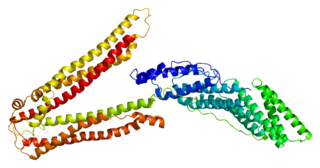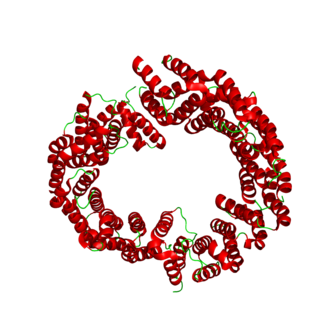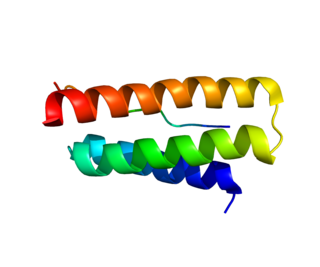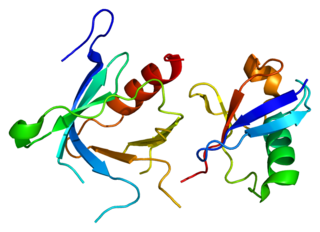Charged multivesicular body protein 5 is a protein that in humans is encoded by the CHMP5 gene. [4] [5] [6]
Charged multivesicular body protein 5 is a protein that in humans is encoded by the CHMP5 gene. [4] [5] [6]
CHMP5 belongs to the chromatin-modifying protein/charged multivesicular body protein (CHMP) family. These proteins are components of ESCRT-III (endosomal sorting complex required for transport III), a complex involved in degradation of surface receptor proteins and formation of endocytic multivesicular bodies (MVBs). Some CHMPs have both nuclear and cytoplasmic/vesicular distributions, and one such CHMP, CHMP1A, is required for both MVB formation and regulation of cell cycle progression. [6] [7]

Tumor susceptibility gene 101, also known as TSG101, is a human gene that encodes for a cellular protein of the same name.

Programmed cell death 6-interacting protein also known as ALIX is a protein that in humans is encoded by the PDCD6IP gene.

Charged multivesicular body protein 2b is a protein that in humans is encoded by the CHMP2B gene. It forms part of one of the endosomal sorting complexes required for transport (ESCRT) - specifically ESCRT-III - which are a series of complexes involved in cell membrane remodelling. CHMP2B forms long chains that spiral around the neck of a budding vesicle. Along with the other components of ESCRT-III, CHMP2B constricts the neck of the vesicle just before it is cleaved away from the membrane.

Charged multivesicular body protein 3 is a protein that in humans is encoded by the VPS24 gene.

Vacuolar protein sorting-associated protein 4A is a protein that in humans is encoded by the VPS4A gene.

Vacuolar protein sorting-associated protein 4B is a protein that in humans is encoded by the VPS4B gene.

Vacuolar protein sorting-associated protein 28 homolog is a protein that in humans is encoded by the VPS28 gene.

Charged multivesicular body protein 4b is a protein that in humans is encoded by the CHMP4B gene.

Transportin-3 is a protein that in humans is encoded by the TNPO3 gene.

Charged multivesicular body protein 4a is a protein that in humans is encoded by the CHMP4A gene.

Charged multivesicular body protein 6 is a protein that in humans is encoded by the CHMP6 gene.

Charged multivesicular body protein 2a is a protein that in humans is encoded by the CHMP2A gene.
It is a reference gene.

Charged multivesicular body protein 1a is a protein that in humans is encoded by the CHMP1A gene.

Vacuolar protein-sorting-associated protein 36 is a protein that in humans is encoded by the VPS36 gene.

Charged multivesicular body protein 1b is a protein that in humans is encoded by the CHMP1B gene.

Vacuolar-sorting protein SNF8 is a protein that in humans is encoded by the SNF8 gene.

Charged multivesicular body protein 4c is a protein that in humans is encoded by the CHMP4C gene.

Vacuolar protein-sorting-associated protein 25 is a protein that in humans is encoded by the VPS25 gene.

Nucleolar protein 4 is a protein that in humans is encoded by the NOL4 gene.
The endosomal sorting complexes required for transport (ESCRT) machinery is made up of cytosolic protein complexes, known as ESCRT-0, ESCRT-I, ESCRT-II, and ESCRT-III. Together with a number of accessory proteins, these ESCRT complexes enable a unique mode of membrane remodeling that results in membranes bending/budding away from the cytoplasm. These ESCRT components have been isolated and studied in a number of organisms including yeast and humans. A eukaryotic signature protein, the machinery is found in all eukaryotes and some archaea.
This article incorporates text from the United States National Library of Medicine, which is in the public domain.